
Lima is the capital and largest city of Peru. It is located in the valleys of the Chillón, Rímac and Lurín Rivers, in the desert zone of the central coastal part of the country, overlooking the Pacific Ocean. The city is considered the political, cultural, financial and commercial center of Peru. Due to its geostrategic importance, the Globalization and World Cities Research Network has categorized it as a "beta" tier city. Jurisdictionally, the metropolis extends mainly within the province of Lima and in a smaller portion, to the west, within the Constitutional Province of Callao, where the seaport and the Jorge Chávez Airport are located. Both provinces have regional autonomy since 2002.

Callao is a Peruvian seaside city and region on the Pacific Ocean in the Lima metropolitan area. Callao is Peru's chief seaport and home to its main airport, Jorge Chávez International Airport. Callao municipality consists of the whole Callao Region, which is also coterminous with the Province of Callao. Founded in 1537 by the Spaniards, the city has a long naval history as one of the main ports in Latin America and the Pacific, as it was one of vital Spanish towns during the colonial era. Central Callao is about 15 km (9.3 mi) west of the Historic Centre of Lima.
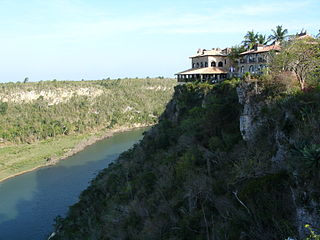
La Romana is a province of the Dominican Republic. The capital is also named La Romana, and is the third-largest city in the country. La Romana was elevated to the category of province in 1944. File:Catalina Island, La Romana, Dominican Republic. A cruise liner in coast waters of Catalina Isl, approaching the rocky shore. .jpg La Romana is also home to Casa de Campo, one of the world's largest resorts and top golfing destinations, including the Teeth of the Dog golf course. Many international and local artists perform at "Altos de Chavón", an artistic community and university.

Cañete Province is located in southern Lima Region, Peru. It is bordered by the Lima Province on the north, the Ica Region on the south, the Huarochirí Province and Yauyos Province on the east, and the Pacific Ocean on the west. Its capital is the town of San Vicente de Cañete District. San Luis is the Capital of the Afro-Peruvian Folklore. Is the most populated province in Lima Region and the third most important province in Lima.

Chorrillos is a district of the Lima Province in Peru and part of the city of Lima. It gets its name from the Spanish word for "trickle of water". The district was founded as San Pedro de los Chorrillos and served as a deluxe beach resort until the late 19th century, when it was almost completely destroyed by Chilean forces during the War of the Pacific.

Lima Province is located in the central coast of Peru and is the only province in the country not belonging to any of the twenty-five regions. Its capital is Lima, which is also the nation's capital.
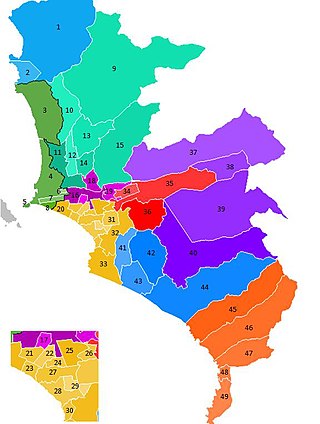
The Lima Metropolitan Area is an area formed by the conurbation of the Peruvian provinces of Lima and Callao. It is the largest of the metropolitan areas of Peru, the seventh largest in the Americas, the fourth largest in Latin America, and among the thirty largest in the world. The conurbation process started to be evident in the 1980s.

La Punta is a district of the Constitutional Province of Callao in Peru, and one of the seven districts that make up the port city of Callao. It is located in a peninsula in the western part of the province and is almost entirely surrounded by the Pacific Ocean, except on its northeastern side, where it is bordered by downtown Callao.

Ancon is a district of northern Lima Province in Peru. It is the popular beach resort of Lima that is visited every summer by millions of people from Lima. Is the largest district of the Lima Province.

Talara is a province in the Piura Region, Peru. It is bordered by the Pacific Ocean on the west, the Paita Province on the south, the Sullana Province on the east and the Tumbes Region's Contralmirante Villar Province on the north. Its capital is the major port city of Talara. It also contains the beach resort of Máncora. The province was created by the President Manuel A. Odría in 1956.

Sofía Mulánovich Aljovín is a Peruvian surfer. She is a 3-time World Surfing Champion, 1 WSL and 2 ISA world championships,. She is the first Peruvian surfer ever to win a World Surf League World Championship Tour event and the first Latin American woman ever to win the World Title, which she did in 2004 In 2004, she won three out of the six World Championship Tour events, and finished the season as Absolute World Champion. Sofia is the only one Latin-american surfer to win 2 ISA World Championships. Sofia won the ISA Championships, 2004 in Salinas-Ecuador and 2019 in Miyazaki-Japan. Her main sponsor is Roxy.

Miraflores is a district of the Lima Province in Peru. It is a residential and upscale shopping district south of downtown Lima. It is also one of the wealthiest districts that make up the city of Lima. It has several hotels, restaurants, bars, nightclubs, and department stores. Miraflores is one of the main tourist destinations in Lima.
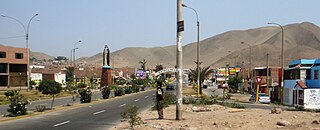
Santa Rosa is a district of the Lima Province in Peru. Officially established as a district on February 6, 1962. The district's postal code is 38. It limits to the north and the east with the Ancón District, to the west with the Pacific Ocean, to the south with the Ventanilla District.

The Asia District is one of 16 that make up the Peruvian province of Cañete. Founded by Beinto Chumpitaz Chavez on July 24, 1964, it was originally part of the Coayllo District.
A Peruvian postal code is a five-digit string that comprises part of a postal address in Peru. Prior to 2011, only the major cities of Lima and Callao used postal codes. However, in February 2011 a nationwide system was implemented which employs a five-digit numeric format. Similar to the postal codes of Mexico, Brazil, Australia, the United States, and elsewhere, postal codes in Peru are strictly numerical, using only numbers.

The valley of Lurín is a district of the Lima Province in Peru. Known for its archaeological temple of Pachacámac, the Pachacámac Island or "La Ballena", countryside areas, villages, fincas, rural restaurants, nightlife and beaches, it is one of the three valleys of the city of Lima.
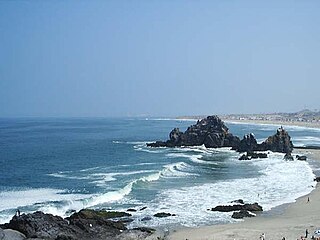
The Peruvian district of Punta Negra is one of the 43 districts of the Province of Lima. It borders the district of Punta Hermosa to the north, the Province of Huarochirí to the east, the district of San Bartolo to the south, and the Pacific Ocean to the west.

San Bartolo is a district in southern Lima Province in Peru. It is bordered by the Pacific Ocean on the west, the district of Punta Negra on the north, the Huarochirí Province on the east, and the Santa María del Mar District on the south.
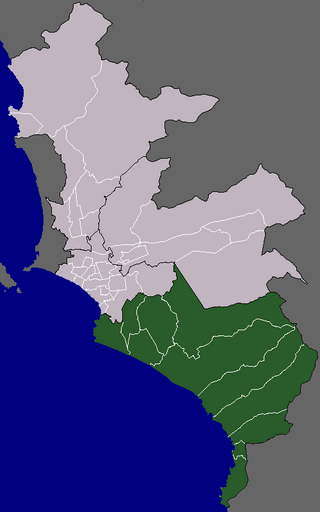
The Cono Sur or Lima Sur is one of the five areas that make up the Lima Metropolitan Area. It is located in the southern part of the metropolis hence its name. This socioeconomic levels of this district are varied. Most of the population however belongs to the lower and middle classes. But it is the area closest to the districts of the modern zone and residential areas like Miraflores, La Molina, Santiago de Surco, etc. Many of the residents belonging to these districts are immigrants from various regions of the country. As they settled there, some developed successful communities such as Villa El Salvador, while others still live in poor housing known as Pueblos jóvenes. The area is popular for its beaches, farms and factories in that population greatly increases during the summer months.

Since the 2000s, Tourism in Peru makes up the nation's third largest industry, behind fishing and mining. Tourism is directed towards archaeological monuments, ecotourism in the Peruvian Amazon, cultural tourism in colonial cities, gastronomic tourism, adventure tourism, and beach tourism. According to a Peruvian government study, the satisfaction rate for tourists after visiting Peru is 94%. Tourism is the most rapidly growing industry in Peru, growing annually at a rate of 25% over the past five years. Tourism is growing in Peru faster than any other country in South America. Iperú is the Peruvian national tourist office.


















